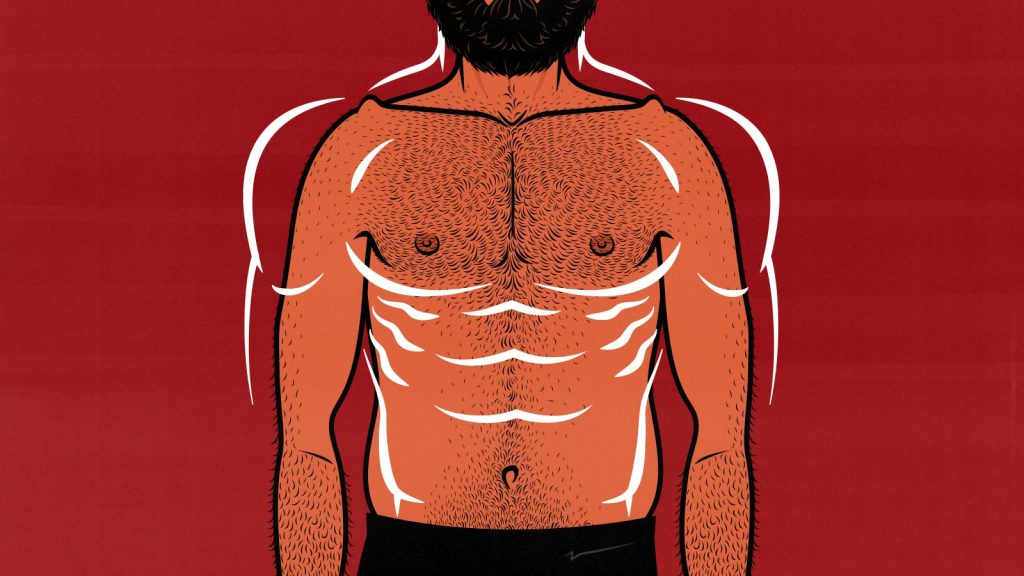
How to Build a V-Taper Physique (Ideal Shoulder-to-Waist Ratio)
Most research shows that a v-taper body shape is attractive to women, looks impressive to other men, and feels nice to have (full explanation). I’ve confirmed that by surveying thousands of men and women, almost all of whom prefer body shapes that are athletic, muscular, and lean (survey 1, survey 2, survey 3).
Most studies compare the chest measurement against the waist measurement (chest-to-waist ratio). Some studies include the shoulders (shoulder-to-waist ratio). Both mean the same thing. They both show that you’re muscular and lean (study). That seems to be what’s driving the effect. That leads to a common mistake, which I’ll cover in a second.
The Ideal Shoulder-to-Waist Ratio
It’s true that most research shows that women prefer men with v-taper physiques (study). That usually means getting shoulders that are about 1.6 times as broad as your waist, giving you a shoulder-to-waist ratio of 1.6-to-1. You can do the same with your chest, building your chest to be 1.4 times as big as your waist, giving you a chest-to-waist ratio of 1.4-to-1.
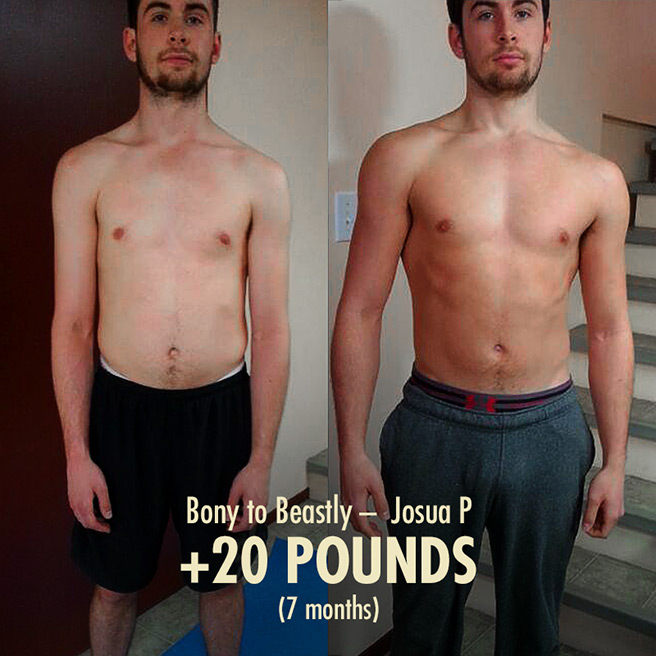
I made an aesthetics calculator that will factor in your height and bone structure and then give you your ideal shoulder, chest, and waist measurements, as well as arm, leg, and neck measurements.
Lower body size and strength seem to matter much less. Perhaps those muscles weren’t as important for gathering or protecting resources. Perhaps they aren’t as strongly associated with strength, masculinity, and dominance. Most fighters and grapplers don’t have particularly muscular legs.
So, if you want to improve your appearance, it may indeed make sense to put at least a bit more emphasis on your upper body. We’ll talk about how to do that. But there’s a misunderstanding we need to address first.
My V-Taper Before/After
I started as a skinny guy with a narrow rectangular body shape. I seem to have gotten it from both sides. My dad was nicknamed “mop” because of his thin build and shaggy hair. My mum was nicknamed “lampshade” because of her curveless figure and bob haircut.
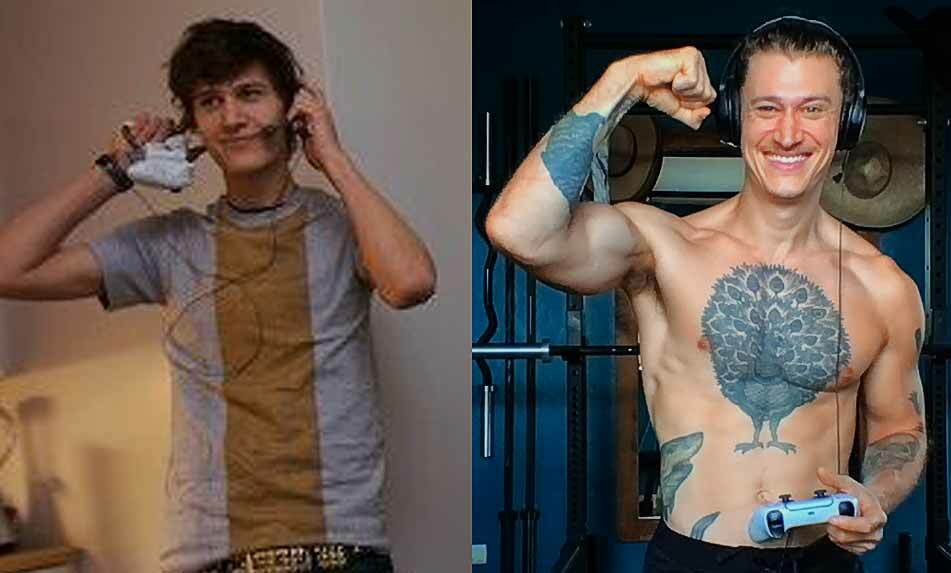
I bulked up over several years, gaining 70 pounds overall (story here). I also brought my bench press from 60 pounds for 5 reps to 225 for 15 reps and my deadlift from 75 pounds for 5 reps to 405 for 8 reps. That was enough to bring my shoulder circumference from 39 inches to 52 inches and waist circumference from 28 inches to 31, giving me a ratio of 1.6 to 1.
If you’re starting as thin as I was, or if you have a significant amount of fat to burn, then this can be a long journey. Fortunately, the earliest steps bring the most benefit. By the time you gain or lose 20 pounds, I suspect you’ll notice a huge difference.
Goodhart’s Law
The problem is Goodhart’s Law: “When a measure becomes a target, it ceases to be a good measure.” A common example is grip strength. The stronger your grip strength, the less likely you are to die (study, study). Some people misinterpret that to mean that building a stronger grip will help you live longer. That isn’t the case. Rather, healthier people are stronger, and stronger people have stronger grips. You can improve your health by getting stronger, but it would be foolish to single out your grip.
In this case, if you hyper-focus on your v-taper, you risk losing sight of what it represents (strength and fitness). If you don’t build a physique that’s actually strong and fit, your v-taper won’t look good, and you won’t get the benefit. I wrote a full article about that here.
For example, in this study by Dr. Sell (study):
- Women correctly guessed which men had the strongest upper bodies.
- Women preferred the men with the strongest upper bodies.
So, it’s good to build a v-taper physique, and it does look good, but you can’t cheat it. You can emphasize your shoulders, but it’s wise to build an upper body that’s strong and balanced. It also probably helps to build legs that are at least reasonably strong.
The Basics
To build a v-taper physique, you need to bulk up your chest, back, and shoulders, and you need to get a trim waist. You don’t need to focus on those specific muscles. You can get almost all of these benefits by following a balanced muscle-building program. But you can exaggerate the effect by doing extra exercises for your chest, shoulders, and back:
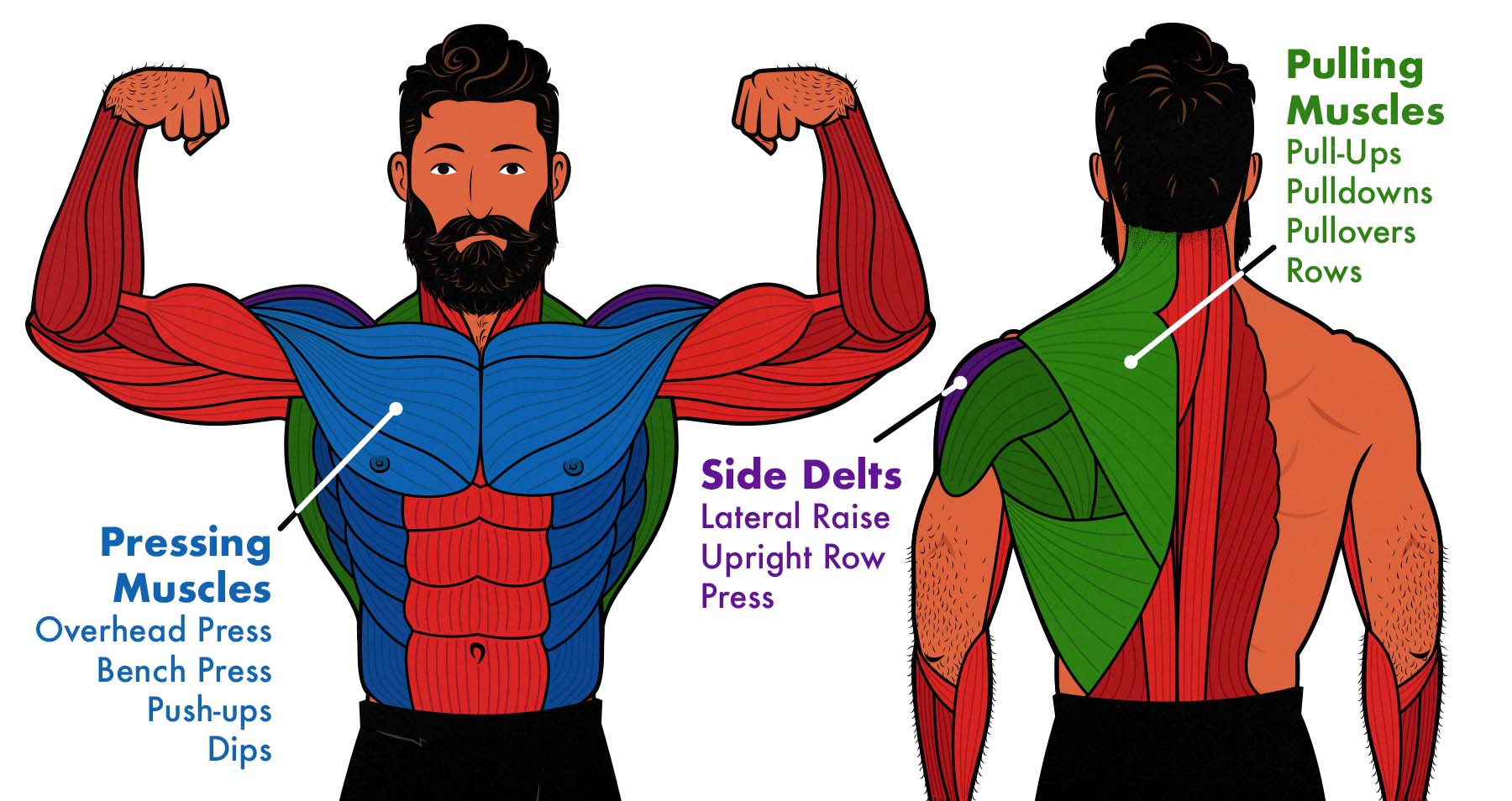
That gives you three paths:
- If you’re overweight, cut (guide here). You need to burn fat while building a little bit of muscle. That will lean out your waist, and your shoulders might get slightly broader as you do it. You might also gain some size in your arms.
- If you’re thin, bulk (guide here). You need to build muscle while staying relatively lean. That will bulk up your chest, back, and shoulders (and everything else) while keeping your waist reasonably lean and trim.
- If you’re skinny fat, recomp (guide here). You need to build muscle and lose fat, and you can probably do both at once. It takes extra energy to build muscle. You can get that energy from your extra body fat.
Those guides cover all the basics. In this article, I want to show you how to emphasize your shoulders, chest, and upper back, giving you a more pronounced v-taper earlier on. I also want to go over the most common misunderstanding.
How to Emphasize Your Shoulders
The best way to build broader shoulders is with overhead presses, upright rows, and lateral raises. These exercises work your front delts, side delts, and rear delts. Your front delts are worked with most pressing exercises (like push-ups), and your rear delts are worked with most pulling exercises (like pull-ups), so it’s the side delts you’ll want to isolate. That’s what lateral raises do, so that’s the key exercise to focus on.
- Overhead Presses: Dumbbell and barbell overhead presses are fantastic for bulking up your front delts and pretty good for your side delts. They also work your serratus anterior, upper traps, and upper chest, along with most of the muscles in your core, making them a great overall exercise.
- Upright Rows: These are a great side delt and upper trap exercise. They might feel weird in your shoulder joint, though. If they do, use lighter weights, refine your technique, or stick to lateral raises.
- Lateral Raises: They’re a small, light exercise. You can do them with dumbbells, weight plates, or even jugs of water. They’re arguably the single best exercise for building a v-taper physique.
You can start with about 10 sets of shoulder exercises per week, but you might want to experiment with going higher, especially if you’re focused on building a v-taper body shape (research breakdown). Pressing and pulling exercises will give you plenty of volume for your front and rear delts, but a few sets of overhead presses and/or upright rows can help.
I also recommend doing 3 to 5 sets of lateral raises three times per week. For example, you could do a few sets at the end of your workouts on Monday, Wednesday, and Friday. I really like the lounging lateral raise for working my side delts at longer muscle lengths. I made a tutorial video:
Shoulder exercises aren’t very fatiguing, and your delts probably won’t get very sore, so you don’t need to worry about overdoing it. Just make sure the exercises feel good on your shoulder joints.
How to Emphasize Your Chest
The best way to build a bigger chest is with horizontal pressing exercises like push-ups, dips, bench presses, chest press machines, and flyes. The best exercises are the ones that are stable, work your pecs at long muscle lengths, and allow for steady progressive overload.
- Push-Ups: Start with a variation that allows you to do 5+ reps, even if that means raising your hands on a bench. As you get stronger, lower your hands down to the ground and raise your feet. The more you can stretch your chest, the more muscle growth you’ll stimulate, so touch your chest to the floor at the bottom of every rep. Even better if you raise your hands by holding dumbbells or parallettes, doing deficit push-ups. Push-ups are perfect until you can do 20–30 of the hardest variations.
- Dips: Once you can do 20–30 of the hardest variation of push-up, you can switch over to dips. Dips work your chest under an even deeper stretch with even more load, and they’re much easier to add weight to (progressive overload). They’re arguably the best exercise for your lower and mid-chest, which are the largest parts of your chest.
- Bench Presses: Dumbbell and barbell bench presses are equally good, and they’re slightly better than push-ups. Dumbbell bench presses put more emphasis on your chest at the cost of less stability and less triceps growth. Incline bench presses allow you to emphasize your front delts and upper chest.
- Chest Press Machines: Chest press machines stimulate about as much chest growth as bench presses. The benefit is that they’re safer and easier to set up. The downsides are that they don’t work as many stabilizer muscles, and you can’t do them at home.
- Chest Flyes: You can use dumbbells, cables, a chest fly machine, or a pec deck machine. Dumbbells are arguably the best because they work your pecs harder at long muscle lengths. The machines are simpler and often feel better, though.
Start with about 10 sets of chest exercises per week. That’s often enough volume to maximize your rate of muscle growth, but you might benefit from working up to as many as 20 sets per week. For example, you could do 4 sets of presses and 2 sets of flyes every Monday, Wednesday, and Thursday, giving you 18 weekly sets.
Chest exercises are quite efficient, though. If you’re choosing good exercises, pushing hard, and going deep, I wouldn’t be surprised if 10 sets were enough. In my case, 10 sets per week was enough to get me a 315 bench press.
How to Emphasize Your Back
Vertical pulls are slightly better for your v-taper. There’s an old saying that horizontal pulls (like rows and deadlifts) are best for building a thick back (because they target the traps and spinal erectors), whereas vertical pulls (like pull-ups, pulldowns, and pullovers) are best for building a wide back (because they target the lats and teres major). Both are important, but it’s the vertical pulls that will build your v-taper.
- Chin-Ups and Pull-Ups: These are the two best overall back exercises. Both of them work your lats and rear delts extremely well. Pull-ups (with an overhand, wider grip) might work your lower lats and teres major slightly harder.
- Lat Pulldowns: I recommend using the opposite grip that you use when doing chin-ups or pull-ups. So, if you’re doing chin-ups with a narrower neutral grip, do your lat pulldowns with a wider overhand grip. That way, you’ll build a more balanced back.
- Pullovers: These are great, especially if you’re training at home with dumbbells. They work your teres major quite hard, and probably your lats, too. If you don’t have access to a lat pulldown machine, do these instead.
You can start with about 10 sets of pulling exercises per week, but feel free to go higher. Your lats and rear delts are tough muscles that are hard to train at long muscle lengths. Higher training volumes can work quite well. So can taking your sets all the way to failure (when you feel it’s safe to do so).
The only thing to watch out for is golfer’s elbow, especially if you’re doing tons of chin-ups or pull-ups on a straight bar. Better to mix it up, using a mix of underhand, overhand, angled, and neutral grips. (If you only have a straight bar, you could get gymnastic rings or these cool Kensui “Swissies” (affiliate links). I have both. Both are great.
The V-Taper Workout
You can build a v-taper with a 2-day, 3-day, 4-day, 5-day, or even 6-day workout routine. 3-day full-body workouts are a classic for a reason, though. They usually make for the best default.
This routine isn’t periodized, but it will give you an idea of what your workouts might look like.
Full-Body Workout 1
We’ve organized these exercises so that you can do supersets. For example, you can do a set of back squats, rest for a minute, drop down for a set of push-ups, rest for another minute, and then do your second set of squats. These supersets are optional, but full-body workouts can get long, and this will help.
All the links lead to tutorial videos of Marco teaching the exercises.
| Exercise | Sets | Reps |
|---|---|---|
| Back Squat | 2–3 sets | 6–10 reps |
| Push-Ups | 3–5 sets | AMRAP |
| Romanian Deadlifts | 2–3 sets | 8–12 reps |
| One-Arm Overhead Press | 3–5 sets | 8–12 reps/side |
| Lat Pulldowns | 3–4 sets | 8–12 reps |
| Lateral Raises | 3–5 sets | 10–15 reps |
This workout focuses on your chest, shoulders, and upper back, but we’re also sneaking in some full-body exercises. Here are my favourite swaps:
- Back Squat: dumbbell goblet squat, front squat.
- Push-Ups: dips, dumbbell bench, or barbell bench.
- Romanian Deadlift: dumbbell Romanian deadlift or conventional deadlift.
- One-Arm Overhead Press: barbell overhead press or machine press.
- Lat Pulldown: chin-up, pull-up, or dumbbell pullover.
- Lateral raises: lying lateral raises or upright rows.
Full-Body Workout 2
| Exercise | Sets | Reps |
|---|---|---|
| Overhead Press | 3–5 sets | 6–10 reps |
| Chin-Ups | 3–5 sets | AMRAP |
| Dumbell Incline Bench | 3–4 sets | 6–12 reps |
| One-Arm Rows | 2–3 sets | 8–15 reps/side |
| Triceps Extensions | 2–3 sets | 8–15 reps |
| Lateral Raises | 3–5 sets | 10–15 reps |
This workout focuses on your back, chest, hips, arms, shoulders, and postural muscles. If you’re advanced, you can do behind-the-neck presses and/or Bradford presses instead of overhead presses, incline bench presses, or lateral raises. If you aren’t advanced, better to stick with the classics.
Here are my favourite exercise swaps:
- Overhead Press: dumbbell overhead press or landmine press.
- Chin-Up: pull-up, lat pulldown, or dumbbell pullover.
- Dumbbell Incline Bench: barbell incline bench or feet-raised push-ups
- One-Arm Rows: bent-over barbell row, seated cable row, or t-bar row.
- Triceps Extensions: overhead triceps extensions, skull crushers, or cable pushdowns.
- Lateral raises: lying lateral raises or upright rows.
Full-Body Workout 3
| Exercise | Sets | Reps |
|---|---|---|
| Deadlift | 2–3 sets | 4–8 reps |
| Push-Ups | 3–5 sets | AMRAP |
| Lat Pulldowns | 3–4 sets | 8–12 reps |
| Goblet Squat | 2–3 sets | 6–12 reps |
| Dumbbell Curls | 2–3 sets | 8–15 reps |
| Lateral Raises | 3–5 sets | 10–15 reps |
This workout focuses on your upper back, chest, shoulders, and postural muscles. Here are my favourite exercise swaps:
- Deadlift: Romanian deadlift or dumbbell step-ups.
- Push-Ups: dips, dumbbell bench, or barbell bench.
- Lat Pulldowns: pullovers, pull-ups, or chin-ups.
- Goblet Squat: front squat, leg press, or dumbbell split squat.
- Dumbbell Curls: curl-bar curls, barbell curls, lying curls, or preacher curls.
- Lateral raises: lying lateral raises or upright rows.
How to Build a V-Taper at Home
If you’re training at home, I recommend building a dumbbell or barbell home gym. That will let you do all of the exercises listed above. It’s the simplest and easiest way to build muscle.
If you don’t want to buy any equipment, you can get scrappy:
- Focus on push-up variations for your chest and front delts. Push-ups are fantastic. No real downside here. Your chest and shoulders will grow just fine.
- Do chin-ups and pull-ups on tree branches or rafters. These aren’t as comfortable as regular chin-ups and pull-ups, but they work, and pull-up bars aren’t expensive.
- Use jugs of water or bags of rice to do lateral raises. It isn’t a heavy exercise, and anywhere between 6–30 reps will be great for stimulating muscle growth.
Full Programs
We’ve got two programs for men that emphasize the upper body while building balanced strength. Both of them are perfect for improving your v-taper:
- Bony to Beastly, our foundational muscle-building program. It’s a 3-day full-body workout program with an emphasis on the upper body. It’s perfect for novices and early intermediates. It includes coaching from us in our online community. You can do it while bulking, cutting, or recomping. You can do it at a commercial gym or at home with adjustable dumbbells or a barbell. We’ll help you gain your first 20 pounds of muscle.
- Outlift, our intermediate hypertrophy program. You can do it while bulking or cutting. It has 3-day, 4-day, and 5-day workout routines, with easy and hard versions of each. The workout sheets will tell you how much weight to load onto the bar each week. The catch is that you need a barbell home gym or a gym membership.



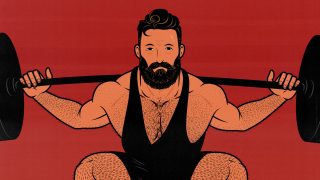
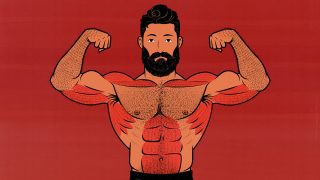
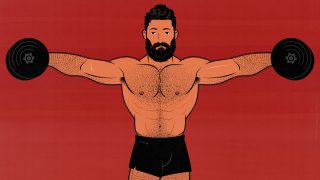
Hi Shane,
It seems you are on a writing spree. 🙂
Liked this article in combination with the Newsletter about the Cobras. I agree, not focus to much on numbers and ratios. The visual experience counts more. My chest to waist ratio is roughly 1.2 far from the „ideal“ 1.4. But I got a strong midsection which is not overly lean but with a flat stomach and a hint of upper abs. In combination with some builit shoulders and pecs it looks already quite decent. On paper with todays Instagram/online standards I am probally skinny fat.
Thanks, Sebastian!
Yeah, that’s how I’d look at it, too. If your chest-to-waist ratio is “off” because your waist is muscular, I wouldn’t worry about it. I’d consider that a good thing, actually.
I think we’re all skinny-fat by Instagram standards. Fortunately, the standards in real life are still pretty reasonable.